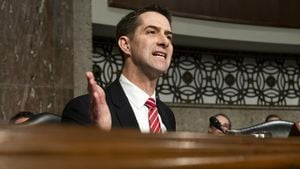The United States is embarking on an ambitious plan to significantly expand its nuclear power capabilities by 2050 amid rising demands for electricity. The announcement, made during the COP29 climate summit currently taking place in Baku, Azerbaijan, outlines the federal government’s strategy to triple nuclear energy capacity as countries around the world grapple with energy challenges.
With the increasing need for electricity driven by various factors—including the burgeoning use of electric vehicles, the rise of data centers integral to artificial intelligence, and the construction of new manufacturing facilities—the stakes have never been higher. Recognizing this reality, federal leaders are prioritizing the nuclear sector, which is gaining bipartisan support, especially from the incoming Trump administration.
The framework proposed by the White House does not mandate sweeping policy reforms or state funding; instead, it leans on existing government authorities to incentivize private sector engagement. The plan seeks to mobilize resources for nuclear energy, emphasizing cheaper and more efficient technologies. Specifically, the program aims to deploy 15 gigawatts of nuclear power by 2035, progressively ramping up to 200 gigawatts by 2050. These new projects could range from large-scale reactors to small modular and microreactors.
Essentially, the new framework is leveraging more than 30 existing governmental powers, and it entrusts the execution to various agencies, including the Department of Energy and the White House. An intriguing uptick has already been noted—as tech giants like Microsoft are forging partnerships to reinitiate operations at older plants like the Three Mile Island, historically significant yet controversial.
The pursuit of nuclear energy, particularly for powering data centers, has attracted several other tech-heavyweights. Google and Amazon are exploring partnerships aimed at securing stable and carbon-free energy sources—thus showcasing the growing appeal of nuclear options. While the initiative has generated excitement among industry proponents, it is not without inherent challenges. Regulatory hurdles and technological barriers must be addressed to fulfill the proposed vision.
Energy experts believe the expansion of nuclear power is not just vitally important for addressing immediate electricity demand but also central to achieving longer-term climate goals. Nuclear energy emits zero carbon, making it one of the few energy sources capable of supporting America's transition to cleaner fuel options. The need for reliable and scalable energy sources is accentuated as climate change increasingly puts pressure on traditional power systems.
Despite the resurgence of interest and investment, the nuclear power sector has historically struggled with public perception, largely stemming from accidents like Chernobyl and Fukushima. Yet, innovations have surfaced, including generation IV reactors and advanced modular designs, which promise to mitigate risks associated with older technologies. The future of these technologies now looks promising, as stakeholders from both the public and private sectors voice optimism.
All eyes are on regulatory frameworks as the upcoming months might clarify the path forward for nuclear energy. The balance will lie between innovation, safety, and public acceptance. Will Americans embrace this renaissance of nuclear energy as part of their future energy mix? The government’s recent initiatives make it clear they are banking on it.



